The Risk Propensity Task (PTR): A proposal for a behavioral performance-based computer test for assessing risk propensity
Abstract
Individual differences in risk propensity have been traditionally assessed by self-report. These instruments are sensitive to response distortion which is not easy to deal with. The paper presents a new objective behavioral performance-based assessment instrument for assessing risk propensity: the Risk Propensity Task (PTR), and its psychometric properties. The first study (N = 234) explores reliability and dimensionality of the PTR. Results show high internal consistency (alpha = .94), and adequate dimensionality. The second study (N = 59) analyzes PTR convergent and incremental validity, using a Sensation Seeking questionnaire (SSS-V), risk-taking behavior self-reports (RTI, SRB) and another performance-based test (BDT). Results show significant correlations between PTR scores and the other instrument scores. The amount of variance explained by the other measures used increases by 6.7% with the PTR. These results indicate that the PTR may be a useful tool in the assessment of risk propensity.Downloads
The works published in this journal are subject to the following terms:
1. The Publications Service of the University of Murcia (the publisher) retains the property rights (copyright) of published works, and encourages and enables the reuse of the same under the license specified in paragraph 2.
© Servicio de Publicaciones, Universidad de Murcia, 2022
2. The works are published in the online edition of the journal under CC BY-SA 4.0 license, a Creative Commons Reconocimiento-CompartirIgual 4.0 (legal text). You are free to:
- Share: copy and redistribute the material in any medium or format for any purpose, even commercially.
- Adapt: remix, transform, and build upon the material for any purpose, even commercially.
The licensor cannot revoke these freedoms as long as you follow the license terms, under the following terms:
- Attribution: You must give appropriate credit , provide a link to the license, and indicate if changes were made . You may do so in any reasonable manner, but not in any way that suggests the licensor endorses you or your use.
- ShareAlike: If you remix, transform, or build upon the material, you must distribute your contributions under the same license as the original.
No additional restrictions: You may not apply legal terms or technological measures that legally restrict others from doing anything the license permits.
This work is licensed under a Creative Commons Attribution-ShareAlike 4.0 International License.
3. Conditions of self-archiving. Is allowed and encouraged the authors to disseminate electronically pre-print versions (version before being evaluated and sent to the journal) and / or post-print (version reviewed and accepted for publication) of their works before publication, as it encourages its earliest circulation and diffusion and thus a possible increase in its citation and scope between the academic community. RoMEO Color: Green.















